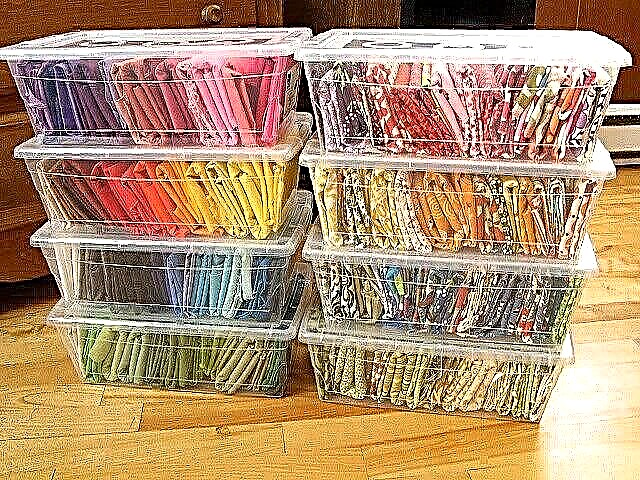In our selection you will surely find a method that is right for you!
Each needlewoman, by her own example, knows perfectly well how the modest stocks of fabrics at the beginning of her career quickly turn into a bottomless treasury, where you carefully take away something that can come in handy “one day”. As a result, storage becomes chaotic and problematic, easily turning into a mess.
Moreover, the incorrect organization of your fabrics harms not only the aesthetic side of your home, but also directly to the fabrics themselves!
What should fabrics be protected from?
 Photo: mommybydaycrafterbynight
Photo: mommybydaycrafterbynight Almost everything is harmful to the state of fibers and dyes:
1. Light, natural or strong artificial, the main enemy of dyed fabrics.
2. Humidity. According to the recommendations for museum rooms where textiles are stored, humidity should remain between 60% -75%. If the air is drier than the lower mark, the fiber will dry out and become more brittle; if the humidity is higher than the upper mark, there will be a risk of mold.
3. Temperature. A temperature of 18 ° C is considered optimal for tissue storage, but this indicator is important mainly because of its direct connection with humidity. In any case, at home, we rarely so closely monitor the temperature in the room.
4. Dust and pollution.A much more dangerous enemy - dust destroys the fibers of the fabric, but hiding from it is not so easy.
One way or another, it is unlikely that your home is in such unfavorable conditions that all these indicators actively affect your tissues, rendering them unusable. Nevertheless, you can always improve the quality of the "life" of your tissues with a careful attitude!
Let's see what are the ways to store tissue, and why some are better than others.
Tissue consumption: how to calculate the right amount
1. Packages
Many needlewomen claim that the most convenient and safest way to store large pieces of fabric for them is vacuum bags for clothes.
 Photo: pinterest
Photo: pinterest
Such bags really protect fabrics or clothes from dust, insects, odors. Their cost ranges from 100 to 500 rubles, depending on size. For sealing you will need a regular vacuum cleaner. Keep in mind: to keep things packed without airing can be no more than six months!
 Photo: pinterest
Photo: pinterest
Yes, you can also use the most ordinary packages, but in terms of storage they are inferior to vacuum ones, both in terms of protection and size.
9 ways to determine the front and back side of the fabric
Tip: sample book
If you have many large cuts that are inconvenient to get if you need to look at them, make a convenient book of samples or, as they are also called, samplers.
 Photo: Sew weekly
Photo: Sew weekly
This can be a special form in which there will be fields for information about the fabric, its composition, footage, etc., together with a glued piece of fabric.Or you can make a very simple notebook where you will paste a tissue sample and write the necessary information next to it.
2. Containers
Transparent plastic containers of different sizes can be purchased in many household and construction stores. For this method, you can come up with different approaches: for example, you can store fabrics by color or composition. Containers can take up quite a bit of space, but not bad protect your fabrics from dust.
 Photo: pinterest
Photo: pinterest 3. Boxes
If you have the option of storing fabrics in drawers at home, this is also a very good option.
 Photo: My Fabric Obsession
Photo: My Fabric Obsession
At the same time, you can fold the fabrics themselves in various ways: in piles, roll up or roll on cardboard.
Lifehack: storage of bobbins
4. Hangers
Hangers for trousers - a very convenient invention that allows ergonomic storage of cuts. In this case, your fabrics are much more susceptible to dust, unlike the previous methods.
 Photo: pinterest
Photo: pinterest 5. Open shelves
With this storage method, your fabrics become almost an element of decor! It looks very beautiful, but leaves your stocks completely defenseless before exposure to light and dust.
 Photo: blackoveja
Photo: blackoveja On the other hand, if you store fabrics that are put into business very quickly and they do not stand on the shelves for months, then there will not be much harm.
Life hack: storing sewing paws
6. Baskets
Those who are fond of the patchwork always have a lot of small cuts and pieces that can be rolled up and stored in open baskets.So they will always be at hand, although for long-term storage the method is again not the most practical.
 Photo: The Craftinomicon
Photo: The Craftinomicon Life hack: make a holder for the second coil



